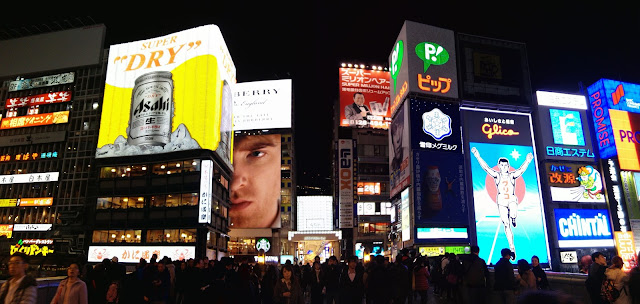4 December 2016
Dotonbori is a large scale downtown along the south bank of the Dotonbori-gawa Canal. Osaka is known as the gastronomists' town, and thus the entire area of Dotonbori is thronged with an unbelievable number of restaurants and amusement facilities, and is dearly loved by the Osakaites.
Dotonbori is often selected as a scene in the Japanese and foreign movies as the symbol of Osaka. There are promenades on both sides of the Dotonbori-gawa Canal to offer better environment for a downtown, which are always attracting visitors and residents. On both sides of the Dotonbori-gawa Canal are lined with advertisements and neon signs. The entire sides of buildings are decorated with neon lamps. The illuminated signboards and neon lamps reflect on the Dotonbori-gawa Canal at night, making Dotonbori even merrier.
Self-proclaimed as 'King of Gyoza' (meat dumplings), this outlet along the famous Dotombori food street can't be missed, not least because there's a giant display of several fibreglass gyoza outside it. But seriously, it's pretty good stuff and the dumplings contain a fairly generous filling.
Most people are probably familiar with Takoyaki, since it is now widely available in many cities around the globe. But Takoyaki in Osaka is just so good and different than what I usually have in Singapore, which is dry and hard.
Takoyaki, also known as octopus ball, is a ball-shaped Japanese street food. It is made of a wheat flour based batter that is filled with diced octopus, pickled ginger, and green onion. Topped with dried bonito, and a douse of mayonnaise and takoyaki sauce, this popular street snack is cheap and delicious. Unlike takoyaki in Singapore which is usually dry, takayoki in Japan is really soft and good.
Shinsekai (新世界) is Osaka's "new world," a district that was developed before the war and then neglected in the decades afterwards. At the district's center stands Tsutenkaku Tower, the nostalgia evoking symbol of Shinsekai.
The area was developed into its current layout following the success of the 1903 National Industrial Exposition, which brought over five million people to the neighborhood within just five months. Shortly after the expo closed its doors, work began to improve and update Shinsekai.
Paris was chosen as the model for Shinsekai's northern half, while the southern portion was built to imitate Coney Island in New York.
Kushikatsu is one of the specialties in Osaka and is known to be one of the identities of Shinsekai’s food scene. Also known as kushiage, kushikatsu is deep-fried meat/vegetable skewers. This is heaven on a stick. Every skewer is coated with light batter and deep-fried to something even lovelier than golden brown; it is delicious and not greasy at all. Many of Shinsekai's kushikatsu restaurants are open 24 hours, but only truly come alive when the lights come on at night.
We passed by this shop which allows you to take different dishes and they charge you by weight. The concept is similar to salad shops in western culture but here you can find both cold and hot dishes.
Variety of foods served in a light, soy-flavoured broth, oden is a hugely popular winter dish in Japan, and usually appears around September or October depending on the region. It is warm, filling and crazy tasty, and can be found from most convenience stores.
Some of the typical ingredients you’ll find in oden, however, can look a little intimidating, and buying some for yourself is made even trickier by the fact that staffs usually require you to tell which ingredients you want, rather than fishing them out for yourself. Among all, I like the tofu and white raddish most. Unlike our yong tofu here which is stuffed with fish paste, it is just plain tofu but its texture and taste are just so good.
This ramen shop is located in a quiet neighborhood near our accommodation J-Hopper. We came to here when we were lost on the way looking for another ramen shop. We saw the signboard on the entrance stating they were rated as the best ramen in 2013 so we thought of giving a try. We could not understand the Japanese menu. The kind lady owner explained to us with very limited English the different kinds of soup base. We ordered one tonkotsu (pork) and one pork + fish soup. I never thought pork and fish can go so well and the taste was just perfect, and it was less greasy than the tonkotsu.
Both soups were thick as you can see in my video below.
I do not like beer but Asahi is probably one of my favorite brands for beer.
It is time to go home..Bye Japan, the cleanest country I have visited.














































